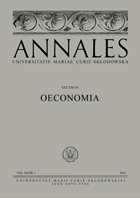The Size of Tax Jurisdiction and Tax Density
The Size of Tax Jurisdiction and Tax Density
Author(s): Artur WalasikSubject(s): Governance, Public Law, Fiscal Politics / Budgeting
Published by: Wydawnictwo Naukowe Uniwersytetu Marii Curie-Sklodowskiej
Keywords: tax density; fiscal federalism; local taxes;
Summary/Abstract: Theoretical background: Theory of public finance theory quite widely recognized that the purest indicator of government size is to observe the determinants and trend of level of public spending. It could be easy translates into the statement that following demand of government for money, first satisfied by taxes, enables to conclude, in particular, that the ratio of tax revenues to gross domestic product is the most appropriate indicator of the fiscal efficiency of the tax system.Purpose of the article: The very aim of paper is to determine, on the basis of constructed original taxation density rate, the diversification of the spatial economics of local revenues from taxation of land and devel- opments. The supplementary goal comes from the identification of attributes of tax jurisdiction size shaping density of taxation. In particular, it is undertaken to determine whether there is a statistically significant difference in the rudimentary statistics of the correlation between the size of tax jurisdiction and intensity of land and development taxation measured by brand new index: tax density.Research methods: The research methods, apart from the query and analysis of the literature on the sub- ject, are descriptive statistics of the population of 2,477 communes in Poland in terms of taxation density and the strength of the correlation between taxation density and attributes of tax jurisdiction defined by its size in both fiscal perspective (total tax revenues, tax revenues per capita) and demographic indexes (population, population density). The area of tax jurisdiction is correspondingly discussed. There is also employed OLS method for study correlation between tax density and indexes of tax jurisdiction size. The data are for the fiscal year of 2021.Main findings: Taxation density is, on average, the highest in urban communes, which results from a significant share of land and improvements subject to property tax. In urban communes, the share of real estate tax is on average 98.91% of total revenues from taxation of land and improvements. While in rural communes, where the lowest average level density of taxation has been recorded, the share in question is on average 73.73%. Examination of taxation density statistics for each of three subpopulations of communes (urban ones, urban-rural ones, and rural ones) indicates that in each case statistics of the distribution of tax density is attributed by positive skew and has sharper peak around the mean, but kurtosis is the highest for rural communes. It has been observed that the shapes of the distribution of total tax revenues, tax revenues per capita and population density are most similar to the shape of the distribution of taxation density in rural communes. The crucial conclusion is that the most significance for tax density growth is the increase of population in accordance with population density. The greater tax jurisdiction measured by population the greater intensity of fiscal exploitation of land occurs. Empirics of tax density for Polish communes fails to observe diseconomies of scale according to population density. There is a very parallel structure of elasticity of tax density for different features of tax jurisdiction, excluding for urban tax jurisdiction two attributes: tax revenues per capita (no statistical significant evidence of elasticity) and area (in contrast to another types of communes elasticity is positive).
Journal: Annales Universitatis Mariae Curie-Skłodowska, Sectio H Oeconomia
- Issue Year: LVII/2023
- Issue No: 4
- Page Range: 201-215
- Page Count: 15
- Language: English

